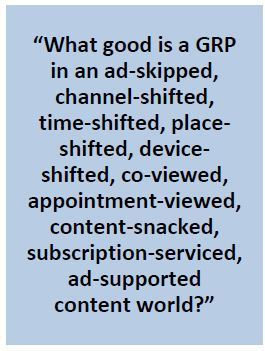
TORONTO – In about 30 minutes, Omnicom Canada CEO Fred Forster put a good scare into a room of broadcasters and ad folks Monday afternoon when describing the impending near future for the TV advertising business.
In a speech to the Broadcast Executives Society lunch Forster, the head of Omnicom in Canada (Omnicom is a $14.5 billion global ad agency) painted a picture of how Big Data is taking over the media buying world, rendering the old metrics of CPMs (cost per thousand) and GRPs (gross ratings points) useless to agencies and their clients
“GRPs and the currency we see today is going to go away,” he added, just prior to making the statement which we turned into our headline above. “We’re in the performance business now, not in the CPM business.”
Omnicom and its various divisions’ clients include such global brands as FedEx, Pepsi, Visa, HTC, HP, Estée Lauder, Vodaphone and Renault/Nissan and Forster outlined some of his company’s most recent initiatives built around tracking and analyzing data so that its clients’ ad buys can be done so much better than in the past. In fact, Annalect, Omnicom’s two year old analytics division, employs 400 people just to crunch data.
What Omnicom does with that data now is aimed at automating ad buying functions based on what it learns – and not on ratings points and traditional demographics. “The end-game is not just to provide data and analytics to clients, but to connect all the moving parts, all the inputs that we have, from media and client information and third party data to make informed decisions for strategy,” and to be able to do it on a daily basis, said Forster.
Forster talked about how his company has used the data to develop a “platform decisioning engine” and content management system which allows the company to see what content is delivering the audiences it wants on what devices, as well as when and where – and then place advertising where it wants to, with content drawing viewers, quickly. As well, more of those decisions are being done by software programs identifying those opportunities and making the call. Forster calls it “programmatic buying.”

“We’re being very, very granular in terms of how we are placing money against very, very specific target groups – and it’s all based on return on investment and that happens over and over and over again,” he explained. “Long gone are the days where we’re simply buying against a demographic group and long gone are the days where we’re simply investing money and hoping that we hit the right target and waiting for the next diary to come out.”
Forster predicted that a lot of money will be spent through programmatic buying as he described on one end – and then also through what he called “big ideas” such as cross-promotional activities between TV channels and integration of products and brands within content. “We still need those big ideas. We need to find ways for our brands to break through.” But in between those two ad-purchasing lines? “The middle is going to disappear,” he added.
Forster also pointed to the small but growing trend of cord-cutting in the States (which has yet to filter into Canada) as a growing challenge, noting that 28% of the people who quit cable in the States last year (cable penetration dipped from 78% to 73% in the U.S. last year, he said) did not bother re-signing with another pay television company. They are getting their content through “curated content gateways” (like iTunes, Hulu, Xbox and Netflix) on smart TVs or other devices from the cloud and not from the traditional TV system.
“So I ask you, what good is a GRP in an ad-skipped, channel-shifted, time-shifted, place-shifted, device-shifted, co-viewed, appointment-viewed, content-snacked, subscription-serviced, ad-supported content world?” he said to an eerily silent room of 200-plus broadcasters, media buyers and agencies.
Forster also pointed out that Big Data’s power rests with those who have that data, such as Google, Apple and Microsoft, three global companies which collectively boast a market value of close to a trillion dollars. In Canada, the big media owners of Bell, Rogers and Shaw have a market cap of less than $70 billion. Big companies in Canada. Small, globally.
“So, I have to wonder why we battle to get bigger and fight against each other in Canada,” he said. “It’s folly to try to get bigger and only think about what we’re doing inside our own borders.”

So, what should the broadcasting industry do now with all of this information and with the shifts ongoing and coming soon? The buyers and sellers have to work more closely together and “stop arguing about things like commercial ratings versus program ratings. We should be thinking about how do I get the information that I have in the set top box – and how to get all that great data I have into the hands of media agencies… and figure out with them how to monetize this data,” he said.
“We need to monetize the data we have so we can get better at targeting,” he continued, which leads to another “must”: to hasten the evolution to addressable TV in the Canadian market, believes Forster. “We are just going way too slow on addressable TV. I understand there are technological issues, but really, the horse has left the barn with respect to the competition that is out there.
“I think we drag our feet because we worry about cannibalizing existing business but this has got to be wrestled to the ground and we all would do well to find ways to beta test and do things that would allow our clients the ability to micro-target with addressable TV.”
Ed note: Here's the Canadian test we know of.



